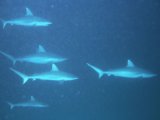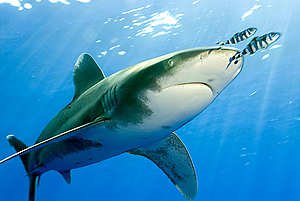Thursday, June 25, 2009
Third of Pelagic Sharks Threatened with Extinction
 The first study to determine the global conservation status of 64 species of open ocean (pelagic) sharks and rays reveals that 32 percent are threatened with extinction, primarily due to overfishing, according to the IUCN Shark Specialist Group.
The first study to determine the global conservation status of 64 species of open ocean (pelagic) sharks and rays reveals that 32 percent are threatened with extinction, primarily due to overfishing, according to the IUCN Shark Specialist Group.“Despite mounting threats, sharks remain virtually unprotected on the high seas,” says Sonja Fordham, Deputy Chair of the IUCN Shark Specialist Group and Policy Director for the Shark Alliance. “The vulnerability and lengthy migrations of most open ocean sharks mean they need coordinated, international conservation plans. Our report documents serious overfishing of these species, in national and international waters, and demonstrates a clear need for immediate action on a global scale.”The report comes days before Spain hosts an international summit of fishery managers responsible for high seas tuna fisheries in which sharks are taken without limit. It also coincides with an international group of scientists meeting in Denmark to formulate management advice for Atlantic porbeagle sharks.
The study reports the Great Hammerhead (Sphyrna mokarran) and Scalloped Hammerhead (Sphyrna lewini) sharks, as well as Giant Devil Rays (Mobula mobular), as globally Endangered and facing a very high risk of extinction in the wild. Smooth Hammerheads (Sphyrna zygaena), Great White (Carcharodon carcharias), Basking (Cetorhinus maximus), Oceanic Whitetip (Carcharhinus longimanus), two species of Mako (Isurus spp.) and three species of Thresher (Alopias spp.) sharks are classed as globally Vulnerable to extinction ( facing a high risk of extinction in the wild).

Scalloped hammerhead (Sphyrna lewini)
(Image: Simon Rogerson)
Many open ocean sharks are taken mainly in high seas tuna and swordfish fisheries. Once considered only incidental “bycatch”, these species are increasingly targeted due to new markets for shark meat and high demand for their valuable fins, used in the Asian delicacy shark fin soup. To source this demand, the fins are often cut off sharks and the rest of the body is thrown back in the water, a process known as “finning”. Finning bans have been adopted for most international waters, but lenient enforcement standards hamper their effectiveness.

Oceanic Whitetip (Carcharhinus longimanus)
(Image: Simon Rogerson)
Sharks are particularly sensitive to overfishing due to their tendency to take many years to mature and have relatively few young. In most cases, pelagic shark catches are unregulated or unsustainable.
The IUCN Shark Specialist Group is calling on governments to set catch limits for sharks and rays based on scientific advice and the precautionary approach. It further urges governments to fully protect Critically Endangered and Endangered species of sharks and rays, ensure an end to shark finning and improve the monitoring of fisheries taking sharks and rays.

Silky (Carcharhinus falciformis)
(Image: Jeremy Stafford-Deitsch)
The IUCN uses a series of categories to classify species
| EXTINCT | The last individual has died |
| EXTINCT IN THE WILD | Only survives in captivity or cultivation |
| CRITICALLY ENDANGERED | Facing an extremely high risk of extinction in the wild |
| ENDANGERED | Facing a very high risk of extinction in the wild |
| VULNERABLE | Facing a high risk of extinction in the wild |
| NEAR THREATENED | Likely to qualify for, a threatened category in the near future |
| LEAST CONCERN | Does not qualify for any of the above |
is the world’s largest global environmental network. It is a
membership union with more than 1,000 government and
non-governmental member organisations and almost 11,000
volunteer scientists in more than 160 countries.
Further Reading:
The Conservation Status of Pelagic Sharks and Rays: Report of the IUCN Shark Specialist Group Pelagic Shark Red List Workshop
IUCN Red List Categories and Criteria booklet
Related Stories:
EU launches shark protection plan
Caribbean Big Fish Disappearing
Mediterranean Sharks Declining Fast
Mexico Passes Shark Finning Ban
Four Times more Sharks caught than Officially Reported
What do you think of this news item? Join a discussion.
Labels: fish, marine biology, research, SCUBA News, sealife, sharks
Wednesday, June 24, 2009
Poseidon Recall Diving Wings
 Poseidon are recalling their Besea W50 Diving Wings (also known as a BCD or stab jacket). The inner bladder inside the diving wing can break, causing the wing to fail as a buoyancy device. This poses a drowning hazard to divers.
Poseidon are recalling their Besea W50 Diving Wings (also known as a BCD or stab jacket). The inner bladder inside the diving wing can break, causing the wing to fail as a buoyancy device. This poses a drowning hazard to divers.The recall involves the Poseidon inner bladders with batch number 5445 sold with the Poseidon Besea W50 wings. The inner bladder is located inside the outer cover of the wing. The batch number and “Poseidon” are molded on a tab located between the “legs” of the inner bladder.
Manufactured in Sweden, they were sold from September 2007 through June 2008.
If you have Poseidon wings that contain the recalled inner bladders then contact Poseidon for a free replacement.
What do you think of this news item? Join a discussion.
Labels: equipment, SCUBA News
Scientists predict Large Gulf of Mexico Dead Zone
University of Michigan scientists say this year's Gulf of Mexico "dead zone" could be one of the largest on record, continuing a decades-long trend.
Most likely, this summer's Gulf dead zone will blanket about 7,980 square miles, roughly the same size as last year's zone, ecologist Donald Scavia said. That would put the years 2009, 2008 and 2001 in a virtual tie for second place on the list of the largest Gulf dead zones.
The Gulf dead zone forms each spring and summer off the Louisiana and Texas coast when oxygen levels drop too low to support most life in bottom and near-bottom waters.
Farmland runoff containing fertilizers and livestock waste—some of it from as far away as the Corn Belt—is the main source of the nitrogen and phosphorus that cause the Gulf of Mexico dead zone.
Each year in late spring and summer, these nutrients make their way down the Mississippi River and into the Gulf, fueling explosive algae blooms there. When the algae die and sink, bottom-dwelling bacteria decompose the organic matter, consuming oxygen in the process. The result is an oxygen-starved region in bottom and near-bottom waters: the dead zone.
The official size of the 2009 hypoxic zone will be announced following a NOAA-supported monitoring survey led by the Louisiana Universities Marine Consortium on July 18-26. In addition, NOAA's Southeast Area Monitoring and Assessment Program's (SEAMAP) is currently providing near real-time data on the hypoxic zone during a five-week summer fish survey in the northern Gulf of Mexico.
Further Reading:
University of Michigan
Most likely, this summer's Gulf dead zone will blanket about 7,980 square miles, roughly the same size as last year's zone, ecologist Donald Scavia said. That would put the years 2009, 2008 and 2001 in a virtual tie for second place on the list of the largest Gulf dead zones.
The Gulf dead zone forms each spring and summer off the Louisiana and Texas coast when oxygen levels drop too low to support most life in bottom and near-bottom waters.
Farmland runoff containing fertilizers and livestock waste—some of it from as far away as the Corn Belt—is the main source of the nitrogen and phosphorus that cause the Gulf of Mexico dead zone.
Each year in late spring and summer, these nutrients make their way down the Mississippi River and into the Gulf, fueling explosive algae blooms there. When the algae die and sink, bottom-dwelling bacteria decompose the organic matter, consuming oxygen in the process. The result is an oxygen-starved region in bottom and near-bottom waters: the dead zone.
The official size of the 2009 hypoxic zone will be announced following a NOAA-supported monitoring survey led by the Louisiana Universities Marine Consortium on July 18-26. In addition, NOAA's Southeast Area Monitoring and Assessment Program's (SEAMAP) is currently providing near real-time data on the hypoxic zone during a five-week summer fish survey in the northern Gulf of Mexico.
Further Reading:
University of Michigan
What do you think of this news item? Join a discussion.
Labels: environment, SCUBA News
Wednesday, June 03, 2009
Snorkeller killed by shark at St Johns, Egypt
A female French tourist was attacked and killed by a shark while snorkelling at the Saint John's reefs in the Red Sea. The first fatal shark attack in Egypt for five years.
The woman's leg showed visible bite marks, and medics said she probably bled to death before being lifted to the surface.
The shark was an oceanic white tip. Although inexperienced divers sometimes confuse it with the white tip reef shark, the oceanic shark is much bigger, stockier and often accompanied by pilot fish. Whereas the reef shark is no threat to divers, the oceanic white tip is one to be wary of and treated with respect. It is almost fearless and credited with many open-ocean attacks on people after air or sea disasters.
Saint John's is in the Southern Egyptian Red Sea. It is a popular destination for divers, a place where you often see large pelagic species. If you should encounter a oceanic white tip it is advisable to stay close to the reef and not to make any sudden movements.
The woman's leg showed visible bite marks, and medics said she probably bled to death before being lifted to the surface.
The shark was an oceanic white tip. Although inexperienced divers sometimes confuse it with the white tip reef shark, the oceanic shark is much bigger, stockier and often accompanied by pilot fish. Whereas the reef shark is no threat to divers, the oceanic white tip is one to be wary of and treated with respect. It is almost fearless and credited with many open-ocean attacks on people after air or sea disasters.
Saint John's is in the Southern Egyptian Red Sea. It is a popular destination for divers, a place where you often see large pelagic species. If you should encounter a oceanic white tip it is advisable to stay close to the reef and not to make any sudden movements.
What do you think of this news item? Join a discussion.
Labels: Red Sea, SCUBA diving, SCUBA News, SCUBA Travel, sharks